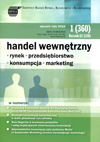Płeć psychologiczna konsumentów a preferowane metody komunikacji rynkowej
Psychological Sex of Consumers and the Preferred Methods of Market Communication
Author(s): Robert KozielskiSubject(s): Business Economy / Management, Communication studies, Present Times (2010 - today), Marketing / Advertising, Globalization
Published by: Instytut Badań Rynku, Konsumpcji i Koniunktur
Keywords: segmentation; psychological sex; marketing communication;
Summary/Abstract: In the context of processes of globalisation and unification of models of company’s customers’ behaviours, there is stronger and stronger exposed the need to consider, apart from quantitative factors (the so-called hard), also other, which describe purchasers’ behaviour. The article is of the research nature and its aim is an attempt to assess, in what degree the psychological sex (the soft criterion) differentiates preferences as regards the methods of market communication against the background of biological sex (the hard criterion). The article is based on author’s own surveys carried out in 2014 on the sample of 343 respondents selected randomly to the survey by the method of auditorium survey. The carried out surveys and the collected empirical data have shown that there is no significant differentiation in the declared opinion and attitudes of the individuals surveyed when we take into account the biological and psychological sex. With a certain caution we can state that there are no unanimous premises to take the research hypothesis, according to which the high degree of differentiation of the expressed opinions, depending on the type of sex (biological versus psychological), would intensify the need for a stronger taking into account the qualitative variables (soft) in the process of marketing activities, including market segmentation. Of course it does not mean disputing the need to take into account the qualitative variables (soft) in the process of analysing purchasers’ behaviours; nevertheless, it indicates quite clear research and practical implications as these conclusions are a peculiar fault on the hitherto indiscriminately uttered opinion on the need for a broad consideration of the socalled soft factors in the analysis of customers’ behaviours.
Journal: Handel Wewnętrzny
- Issue Year: 357/2015
- Issue No: 4
- Page Range: 232-242
- Page Count: 11
- Language: Polish

